All of us knows Pep Guardiola’s Manchester City dominated English football in the past two seasons. However, before the ‘Centurions’ and the ‘Fourmidables” campaigns, the Citizens suffered a lot in the Premier League. One of Guardiola’s biggest defeats in his managerial career was a humiliation at Goodison Park in January 2017. In that game, Ronald Koeman’s Everton struck four against Manchester City.
In this tactical analysis, we will show you the details of the game. It is an analysis that focuses on the tactics of the game.
Lineups
Everton started in a 3-5-1-1 formation. Ramiro Funes Mori, Ashley Williams and Mason Holgate formed the back three. The midfield three were Ross Barkley, Gareth Barry and Tom Davies, and they made an impact in the game. Romelu Lukaku was supported by his Belgian teammate, Kevin Mirallas.
For City, they played in a 4-3-1-2 without any conventional wingers. Bacary Sagna started as the right-back. Therefore, Pablo Zabaleta played as the right midfielder, partnered with Yaya Touré and Kevin De Bruyne. Raheem Sterling and Sergio Agüero paired as the strikers upfront.
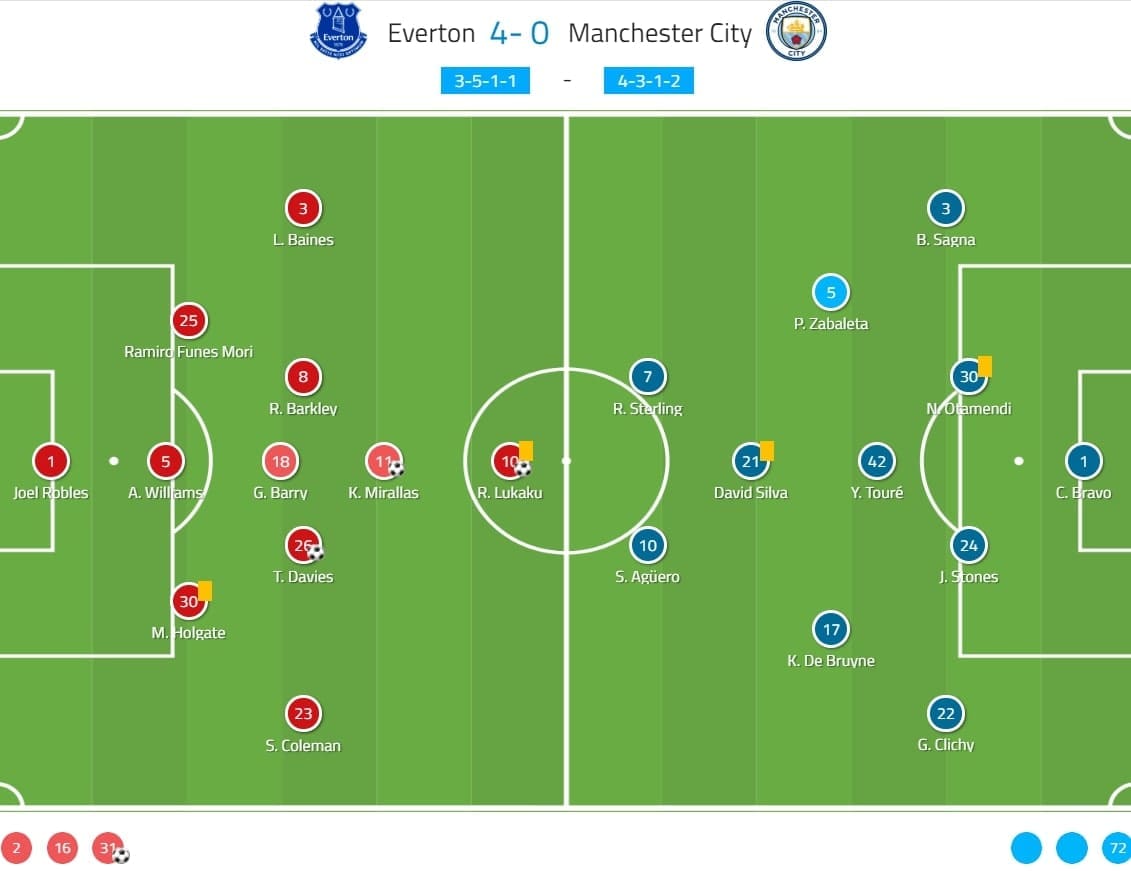
Everton’s defensive style of play
Koeman’s team were well prepared for the game; in the hope of making City’s build-up more difficult, they maintained a certain level of pressure. With the front five, Everton could partially man-mark the City players, as shown in the below image, while the wing-backs were tasked with controlling Sagna and Gaël Clichy.
This approach required huge defensive efforts from the midfield trio. As you can see, if Barkley stepped out to approach Nicolás Otamendi, he had two City players behind. It fell for Barry to cover the free player. During the press, they had to be quick, and though the Toffees might not always have won the ball in the central third, by no means did they let City players turn.
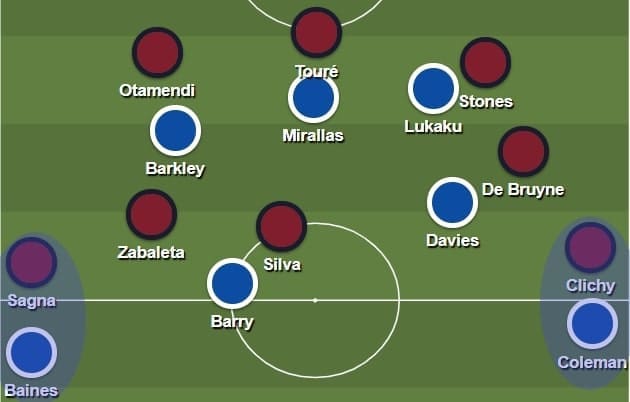
The following image demonstrated the pressing shape of Everton. The first line of press man-marked the first layer of City’s build-up. In this case, Sagna and Zabaleta were behind the first line. Therefore, Barry stepped up to compress the space between lines. The experienced Englishman cleverly positioned himself between Sagna and Zabaleta, hence, kept both of them under control. The denial of all short options forced Claudio Bravo to play long.
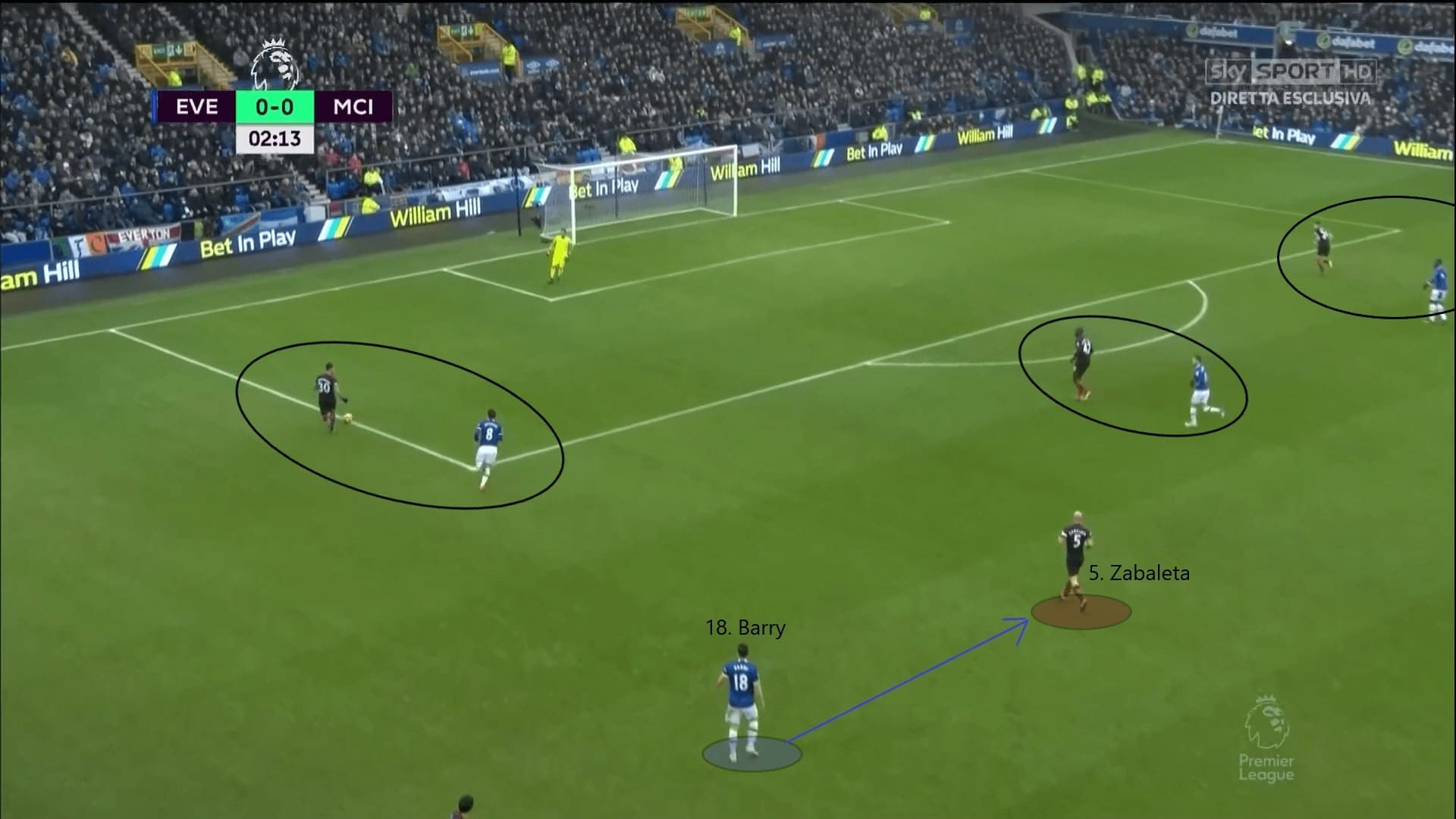
When defending deep, Everton players were disciplined to swap positions to cover each other. This allowed their block to remain compact and narrow, and City found it difficult to penetrate within the box. They restricted the xG of Guardiola’s team to 0.81 from 12 shots.
The following example illustrates the beautiful defensive shape of Everton’s defensive block. When City switched play to Clichy, the defensive positioning of the Toffees was a bit asymmetrical in that moment. Since protecting the half-spaces was the priority, as well as maintaining the compactness of the defence, Séamus Coleman quickly stepped to the midfield line. The Irishman shut the passing lane to Sterling. Meanwhile, Holgate moved wide to approach Agüero, shutting another potential option for Clichy.
Apart from the midfield line and the defensive line, there was one additional layer to compress spaces between the lines. Barry was there to pick the free players, if any. Given the well-organized Everton block, Clichy recklessly played a vertical pass, and it was intercepted.
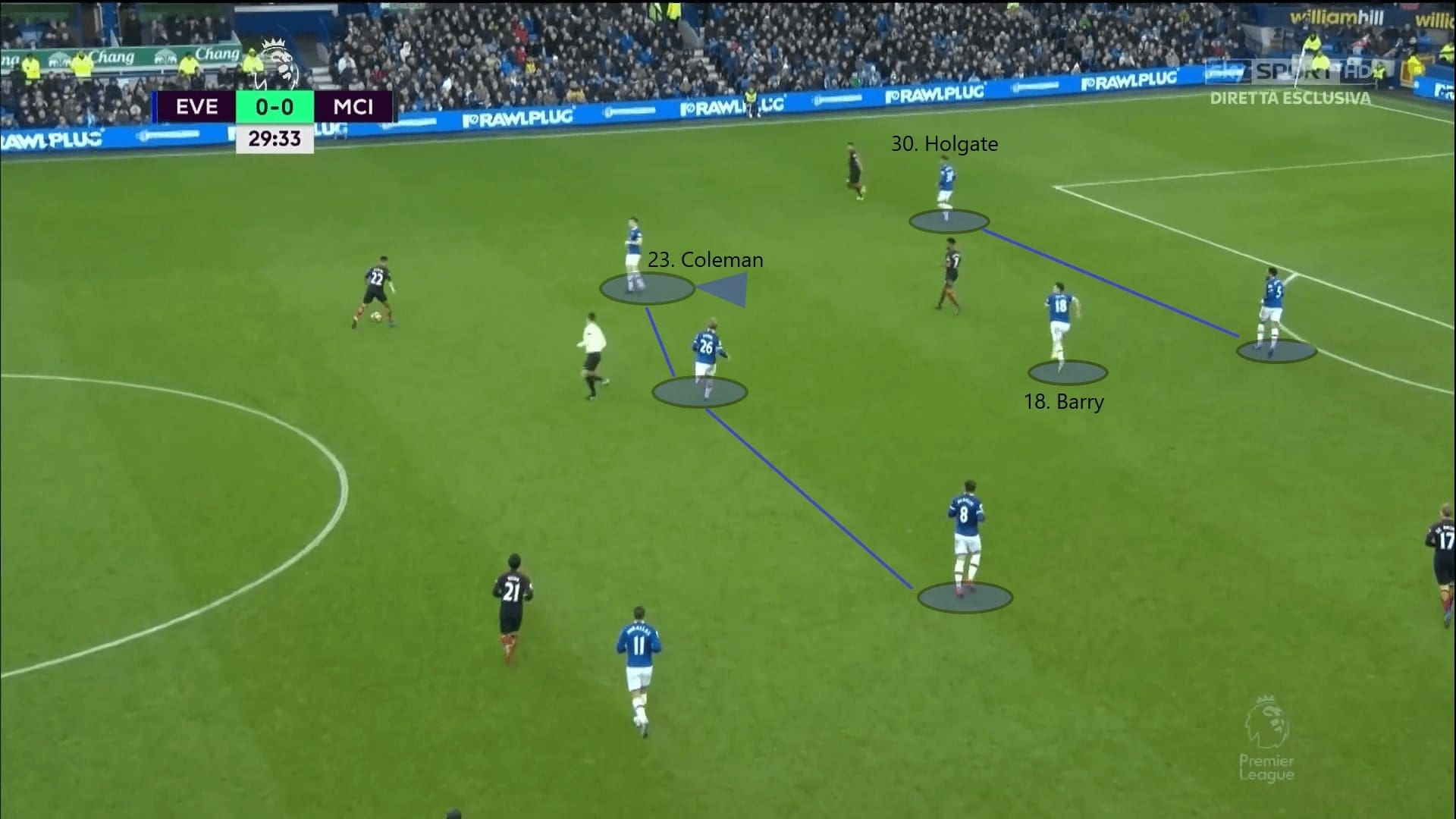
Playing out from the back
As for City, they insisted on playing out from the back. The setup could be briefly summarized as shown in the following image. The task of the full-backs was to position themselves wide to provide the width, stretching the defence. For the midfield three, Touré was allowed to drop between the centre-backs to connect plays. Zabaleta and De Bruyne stayed in the half-spaces to stretch the block.
In the following image, hypothetically, City could directly access their front players through a penetrating pass at the centre. These passes were made easier by the positioning of the above players, who stretched the defence. Then, ideally, City could directly attack the back three of Everton.
Another benefit of this five-man build-up was to keep a numerical advantage in the first phase of the attack. Only 12.5% of City’s losses occurred in their own third. Players in the midfield diamond were given the freedom to roam from their position, as it was important for them to occupy different vertical zones of the pitch.
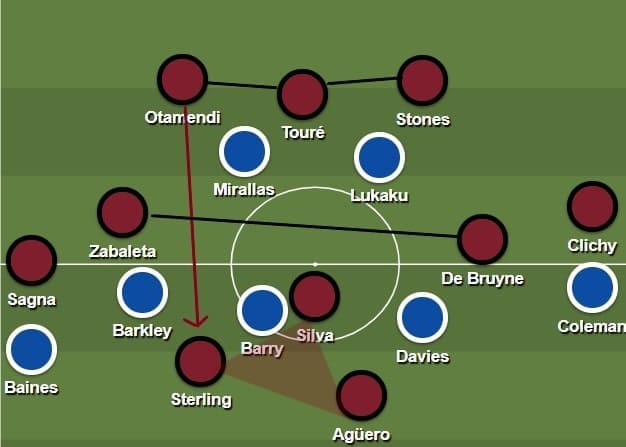
The following image is a game example of City’s build-up shape. Does it look familiar? Actually, City are still using this shape to play out from the back, though inverting the full-backs was a major difference.
With these two layers of build-up, City could easily bypass the first line of pressure and progress the ball. Guardiola was pleased to let Touré play the progressive pass, as the Ivorian had a better vision and passing ability than the centre-backs.
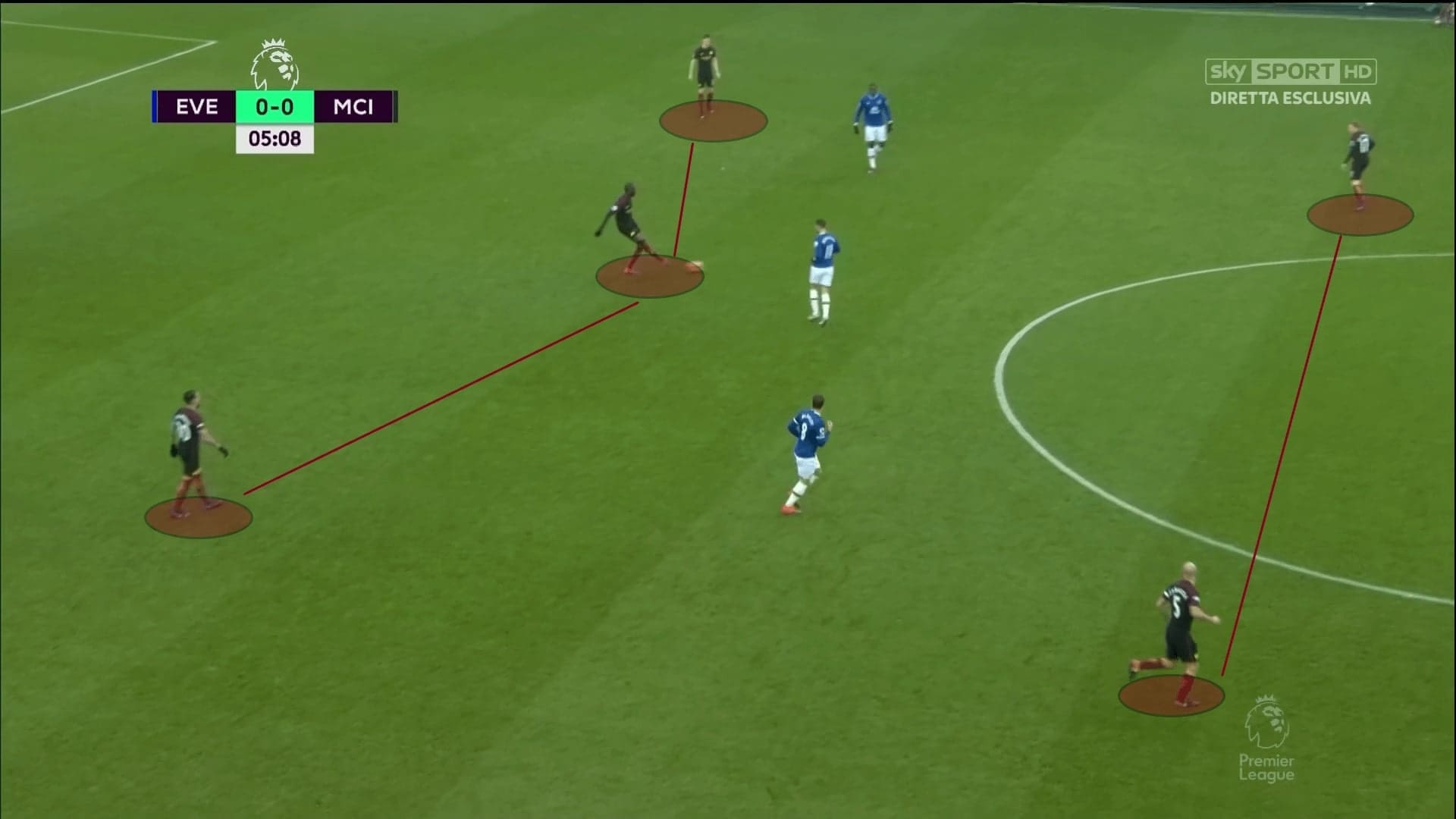
In the following image, Touré exercised a pass with a wider angle from his deep position. Please also note at Zabaleta and De Bruyne’s positions; they occupied the half-spaces and opened a wider passing lane. As City wished, they reached a front player, who was Agüero in this scenario. The highlighted area showed the huge spaces generated once City bypassed the block of Everton.
However, it was very difficult for the front players to receive the ball by the dropping movements, as, the Everton centre-backs also stepped out and pressured the receiver from behind. Given the suboptimal body orientations of the dropping players, this approach did not work too well.
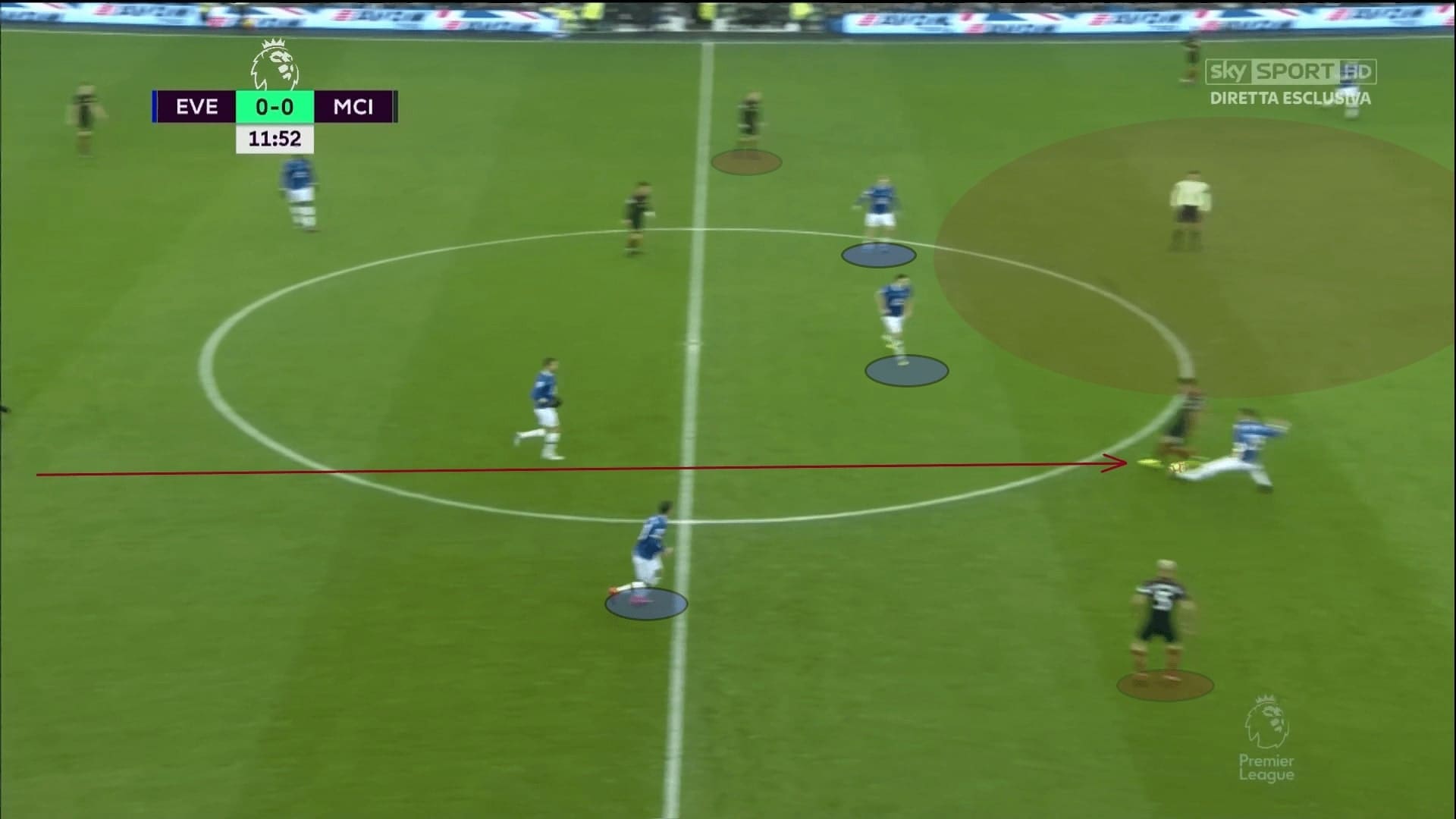
City in the final third
To further explain the offensive approach of City, we are going to explain their movements in the final third. As explained, De Bruyne positioned himself in the half-spaces in the build-up phase. Opening a wider passing lane was not the only advantage. Furthermore, this helped City attack the box with blindside runs, combined with the passing ability of the Belgian.
Whenever De Bruyne had the ball in the left half-space, he drew the attention of the Toffees. As a result, all of the defenders’ body orientations were suboptimal as they all looked at their right flank.
As you could see in this image, the entire defence only looked at De Bruyne. This is the moment for City players on the far side to make blindside runs. In this case, Sterling identified spaces behind the defender, and he started a run to exploit those spaces. It was an easy task for De Bruyne to feed the ball into that zone and help City to access the penalty box easily.
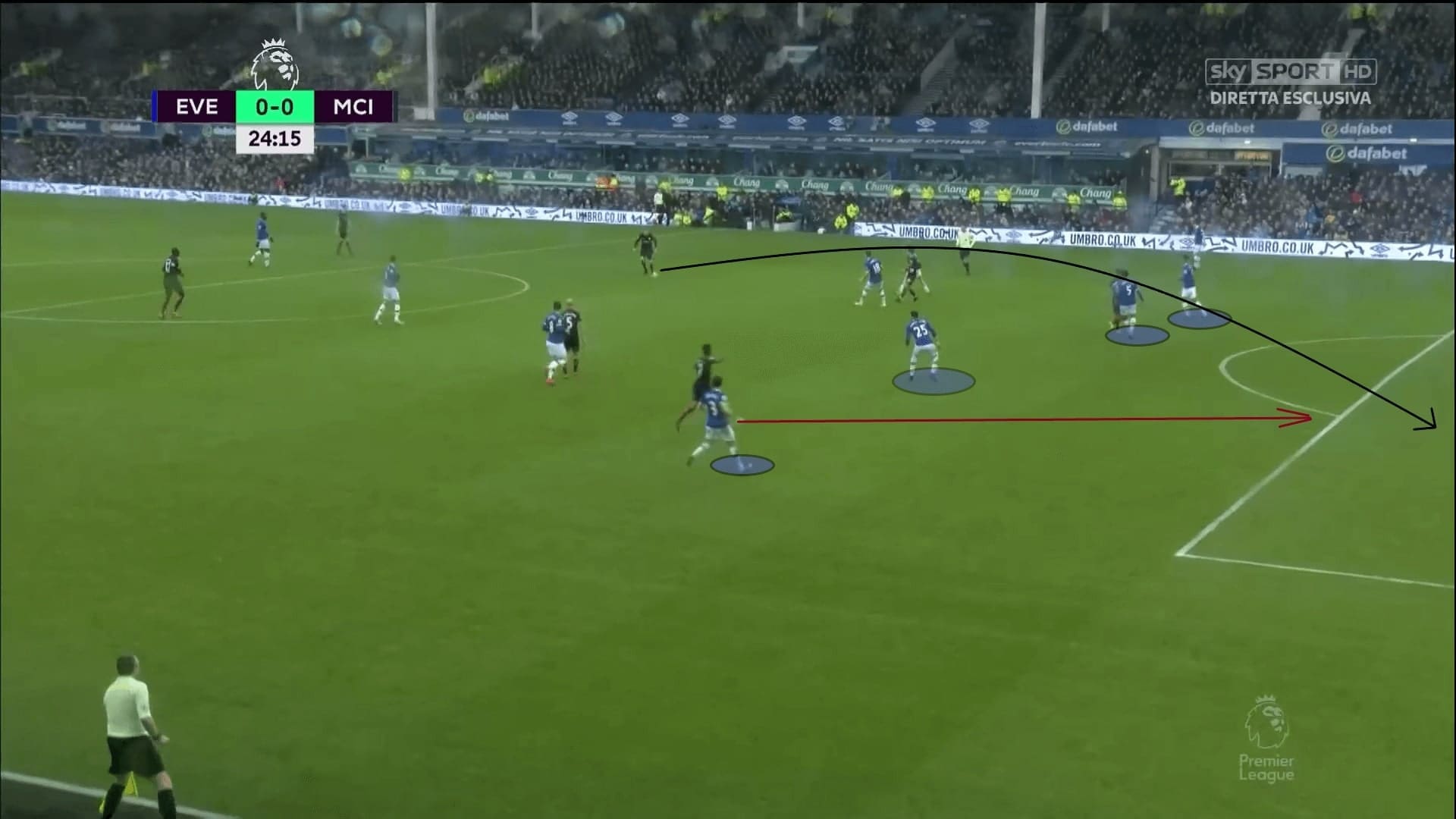
However, City did suffer from their positional plays, mainly because of structural issues. They were unable to create huge chances, apart from the blindside movements as explained above, and the offensive transitions that we are going to address in the coming section. Among all the chances of City, the highest xG was only 0.16, which came from a freekick of Touré.
The full-backs struggled when they were isolated in the wide areas. Both Clichy and Sagna were over 30, and joining the attack was not their best attribute. Therefore, even though they had some 1 v 1 opportunities, hardly could they pose a menace to Everton’s defence. For example, what could you expect from Sagna, when he had to deal with Leighton Baines alone in this case? It was unrealistic to expect the Frenchman to take on the wing-back, drive to the byline and cross.
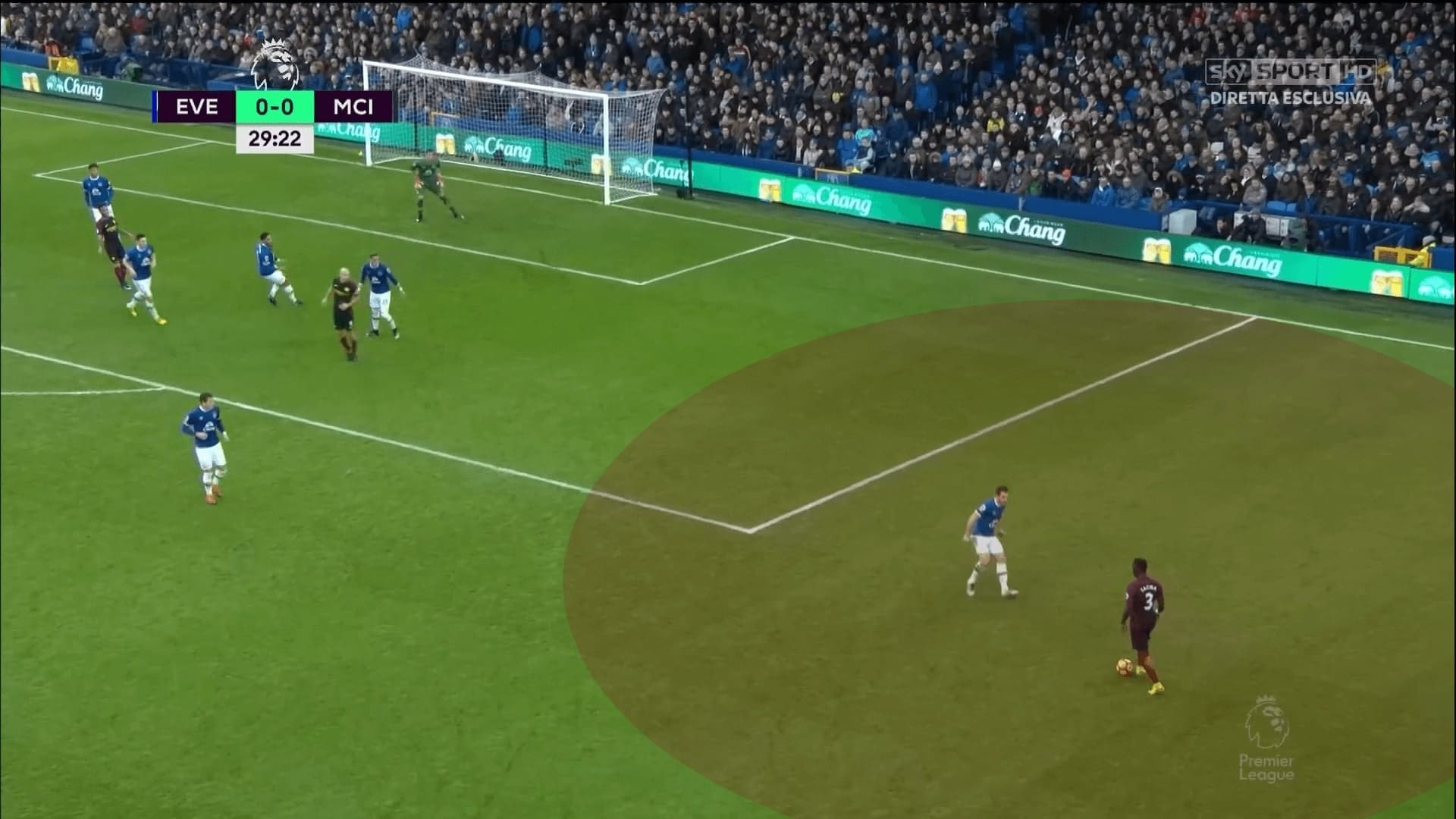
In the second half, City’s approach in the final third was slightly different. Since De Bruyne was free and he roamed from his position from time to time, City tried to attack spaces behind the defence by luring Holgate out. City kept placing players around Holgate, and tried to take him away from the defensive line, creating spaces behind the young centre-back. In the following image, you could see Kelechi Iheanacho did manage to draw Holgate out.
However, as explained, the defensive block of Everton was too good. Even though the gaps were generated in an instant, City were not quick enough to seize that moment to produce the key pass. And, those gaps soon vanished due to the covering of other Toffees. For example, Sterling was running towards Holgate’s back, but he was tightly chased by Barry, and he was under control.
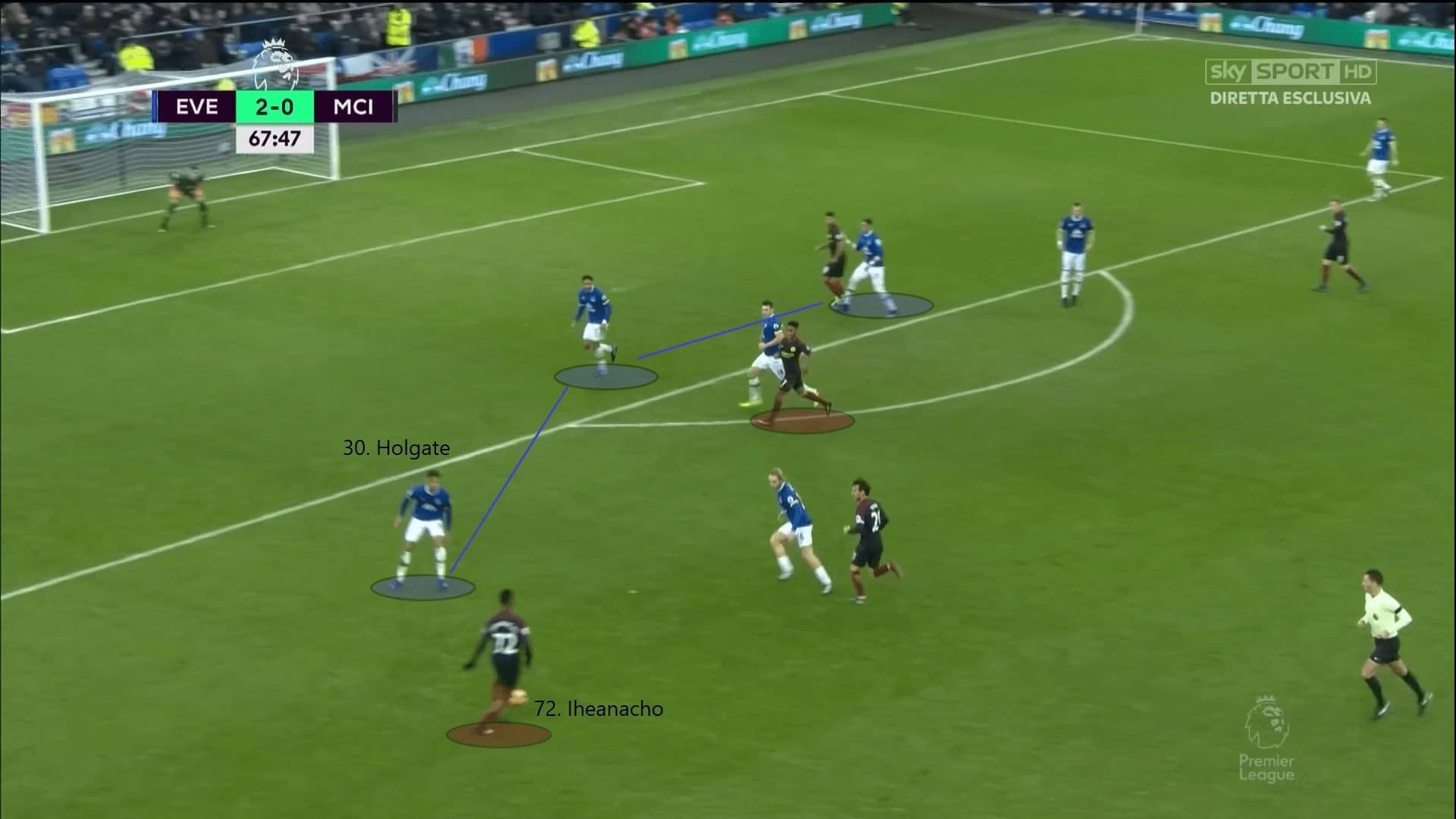
Offensive transitions
Since the positional plays of City did not work too well, they created the chances through the offensive transitions. In this game, their front players were doing well to run at the flanks during the counter-attacks, creating greater spaces. In the first half, De Bruyne always moved to the left corridor and crossed from that position. City had the ability to start counter-attacks thanks to the quality of the individuals.
For example, you could see Agüero’s line-breaking pass found Sterling at the centre and it became a 3 v 2 situation at Everton’s backline. Meanwhile, on both flanks, the Citizens had Zabaleta and De Bruyne to run wide, further stretching the defence.
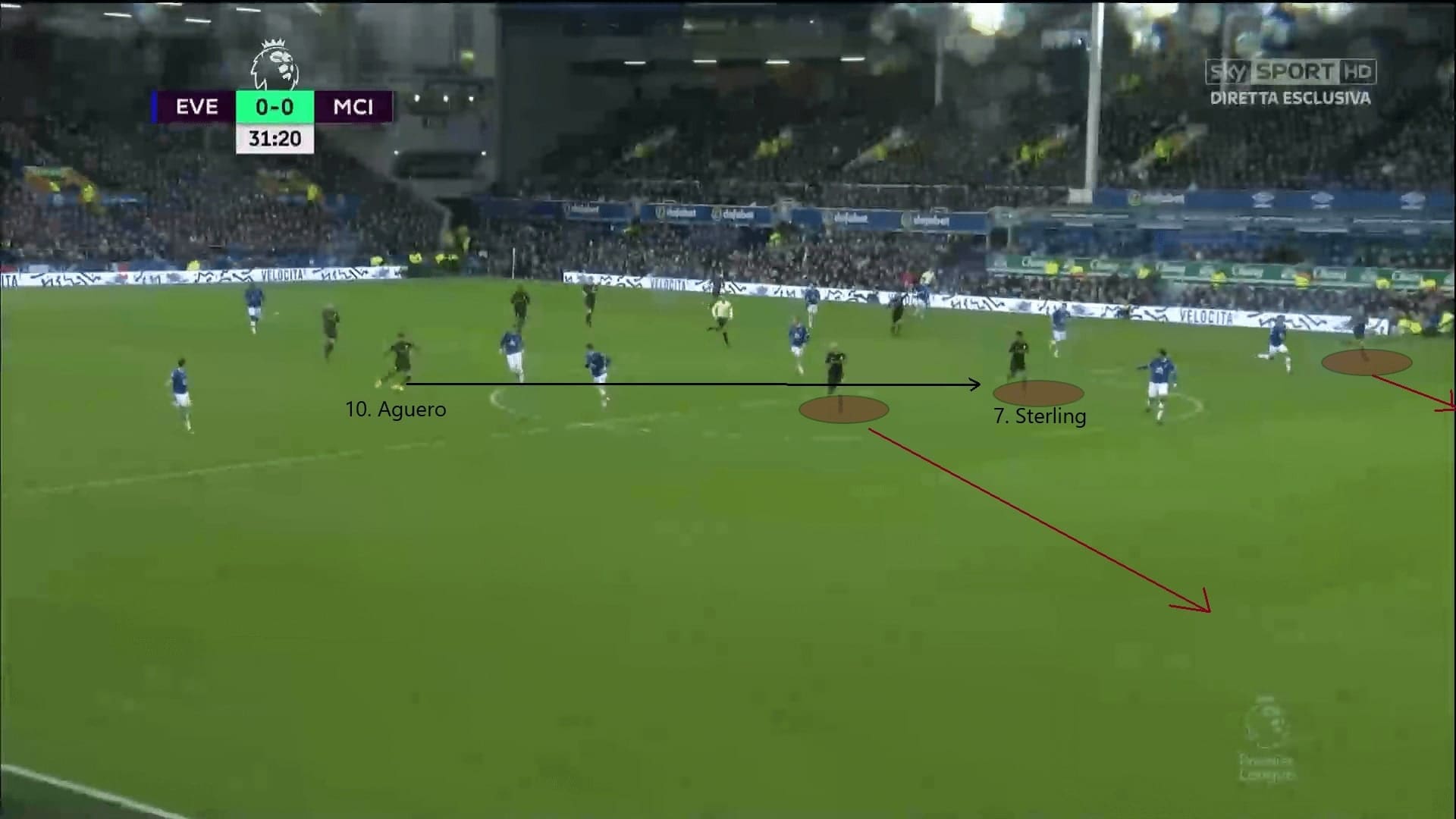
Exposed structure
The biggest issue of City in this game was their exposed structure. They lost the dominance of midfield because of the explained setups in the build-up phase. Since the midfield three (Touré, Zabaleta and De Bruyne) spread too wide, at the moment they lost the ball, they were slow to compress space. By contrast, Everton’s midfield three were more compact and mobile at the centre. The triangles in the following image indicated the distances of the midfielders.
Also, since Touré dropped between the centre-backs, City lost the numerical equality at the midfield. Although Silva or Sterling could drop, they picked a more advanced position, and so City still lacked protection to the backline. On so many occasions we could see an Everton player carrying the ball forward, without a City player stopping him.
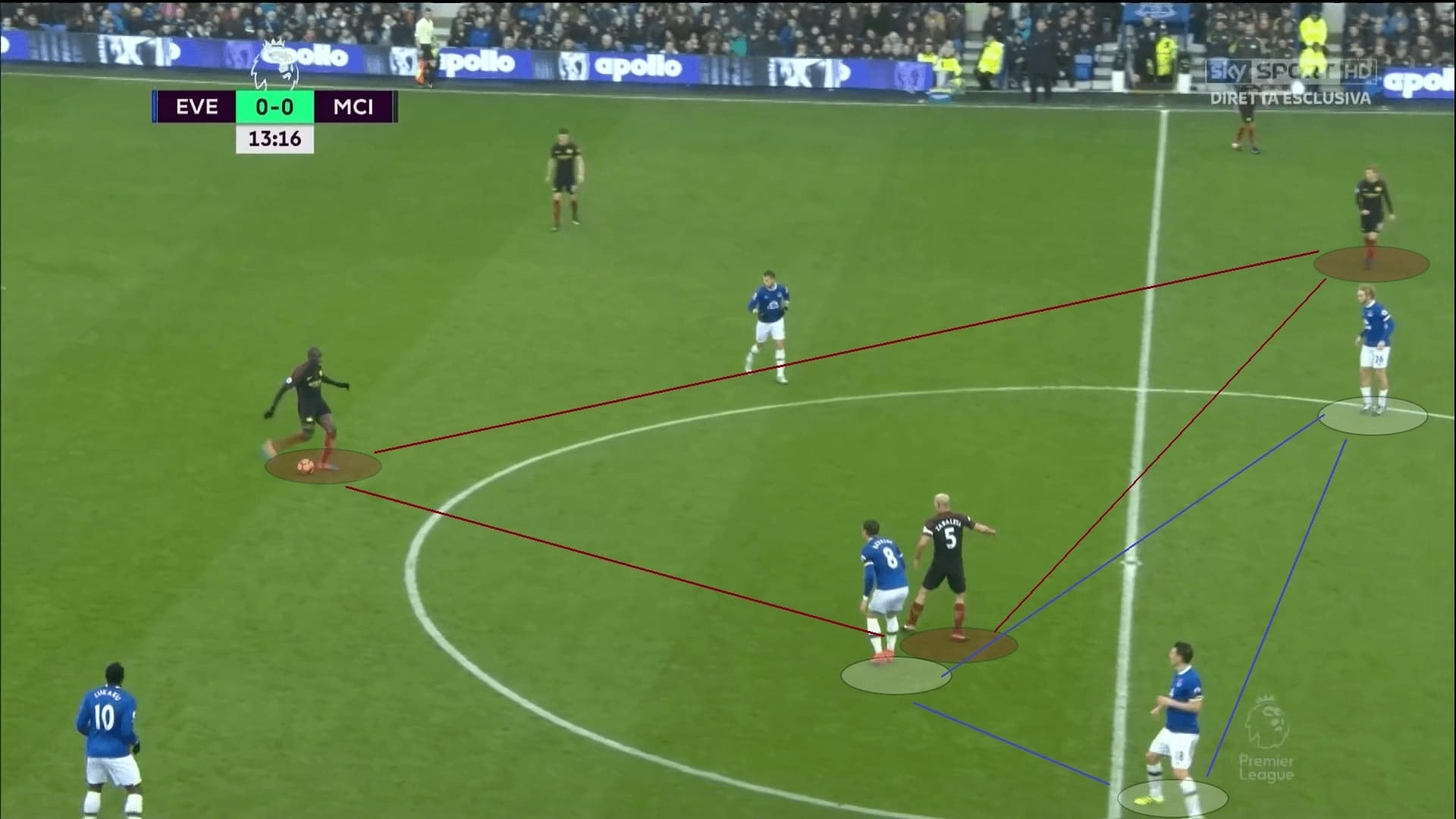
Despite playing as a centre-back at Barcelona, it was not a good idea to let Touré defend deep. The following image showed the situation of how Everton created the first goal. In this scenario, Stones and Touré swapped their position. In other words, the Ivorian was the centre-back permanently.
However, playing Touré at the backline in 2017 was a crime. First, he lacked the defensive awareness to reduce the gap with his teammates. And, because his body orientation was suboptimal, Mirallas could stay at his blindside easily and run behind the defenders.
Another point we are briefly touching with this image was the horizontal distance between the City defenders. They were not compact enough, and, without the protection of the midfielders, it was very easy for Davies to penetrate vertically.
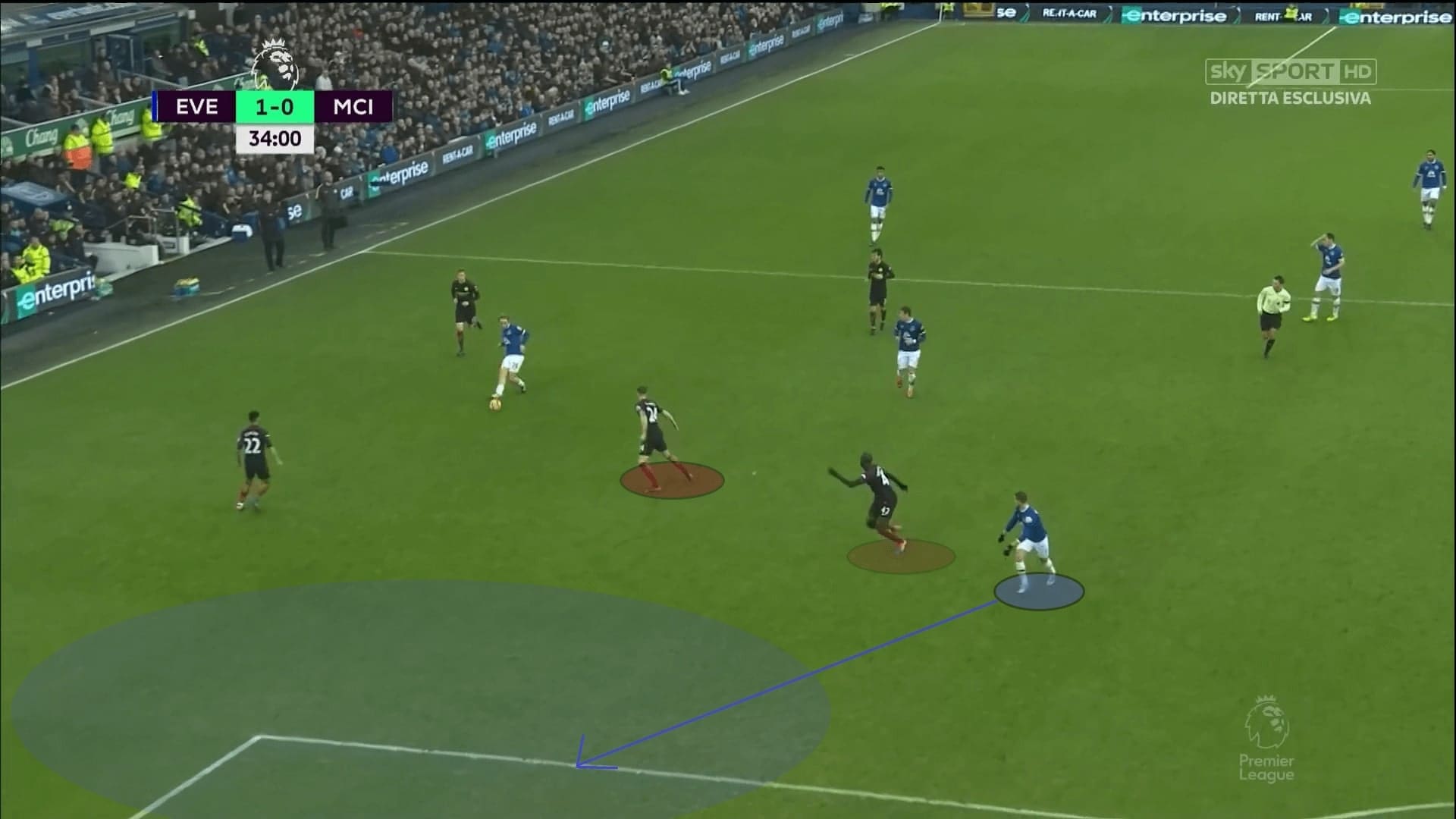
Another issue of City was their poor reaction when they lost the ball. The duels win rate of Guardiola troops was only 40% in the first half. Whenever they lost the ball, the nearest player stepped out to engage the ball carrier, and, they lost the duels, as well as a number in the defence.
For example, you can see Touré was on the floor as he failed to stop the progression of the pass. And, Lukaku only had the side midfielders of City in front of him, and both of them were coming from a wider position as the build-up positionings explained. They are too far from stopping Lukaku.
This was how the second goal was created. Clichy was too far away from Stones, and was unable to close the gap or reduce spaces at the centre in an instant. City were vulnerable when defending the transitions.
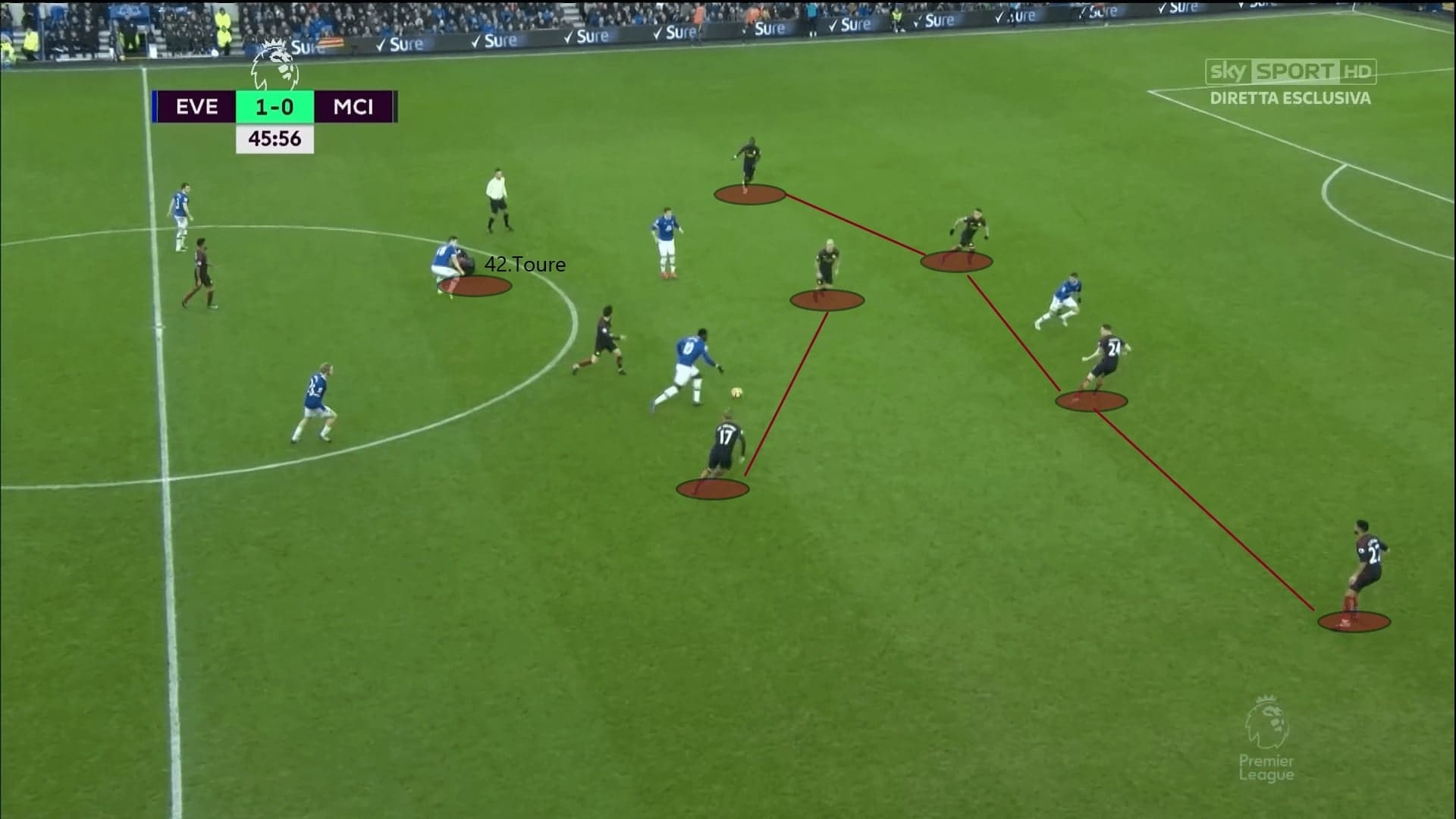
Apart from the midfield, City’s defence was exposed because of the high line. Their defenders lacked the pure pace to track the opponents. They also found it very difficult when dealing with Lukaku, who was physically strong and quick.
In this image, you could see the issues at once. At the midfield, Touré was on the floor again, as Barry escaped his challenge and enjoyed space to execute his next move. De Bruyne and Zabaleta were way too wide to stop him, again. Meanwhile, Lukaku was ready for a run behind the defenders already.
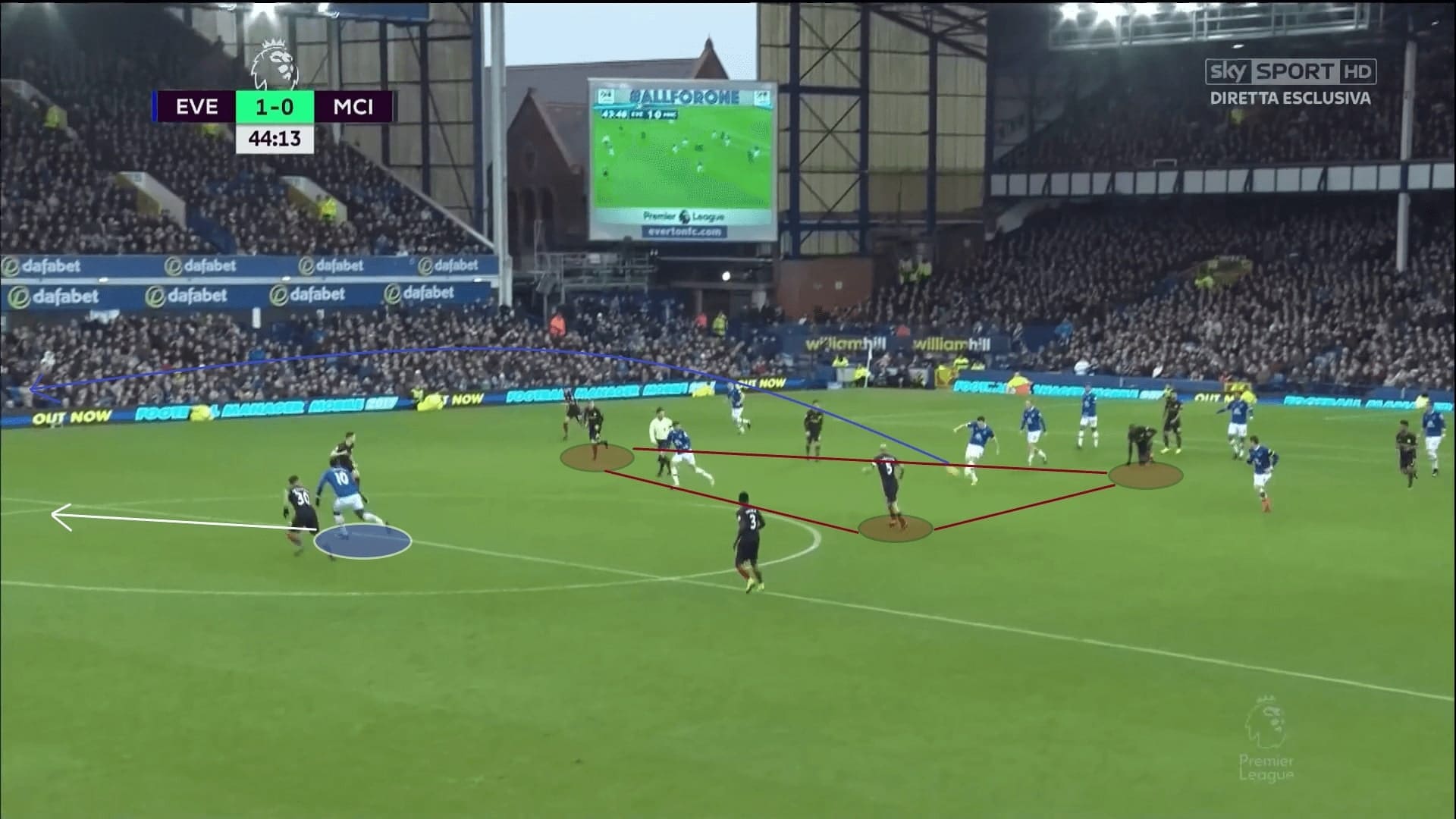
Attacking the key areas
For Everton, their attack was planned to expose the weaknesses of City. Some key areas of the Citizens were identified. First, we take a look at their first phase of the attack. Intriguingly, the back three of Everton split very wide, as indicated in the following image.
The Toffees were not opting to play out from the back, all they wished was to invite the pressure from City. In hopes of denying the short options of Everton, City players quickly stepped up, with Silva, Sterling and Agüero forming the first line of press and blocking the back three. So, when Barry appeared, it fell to Zabaleta to follow. All of this created more space for the front players in the coming long passes.
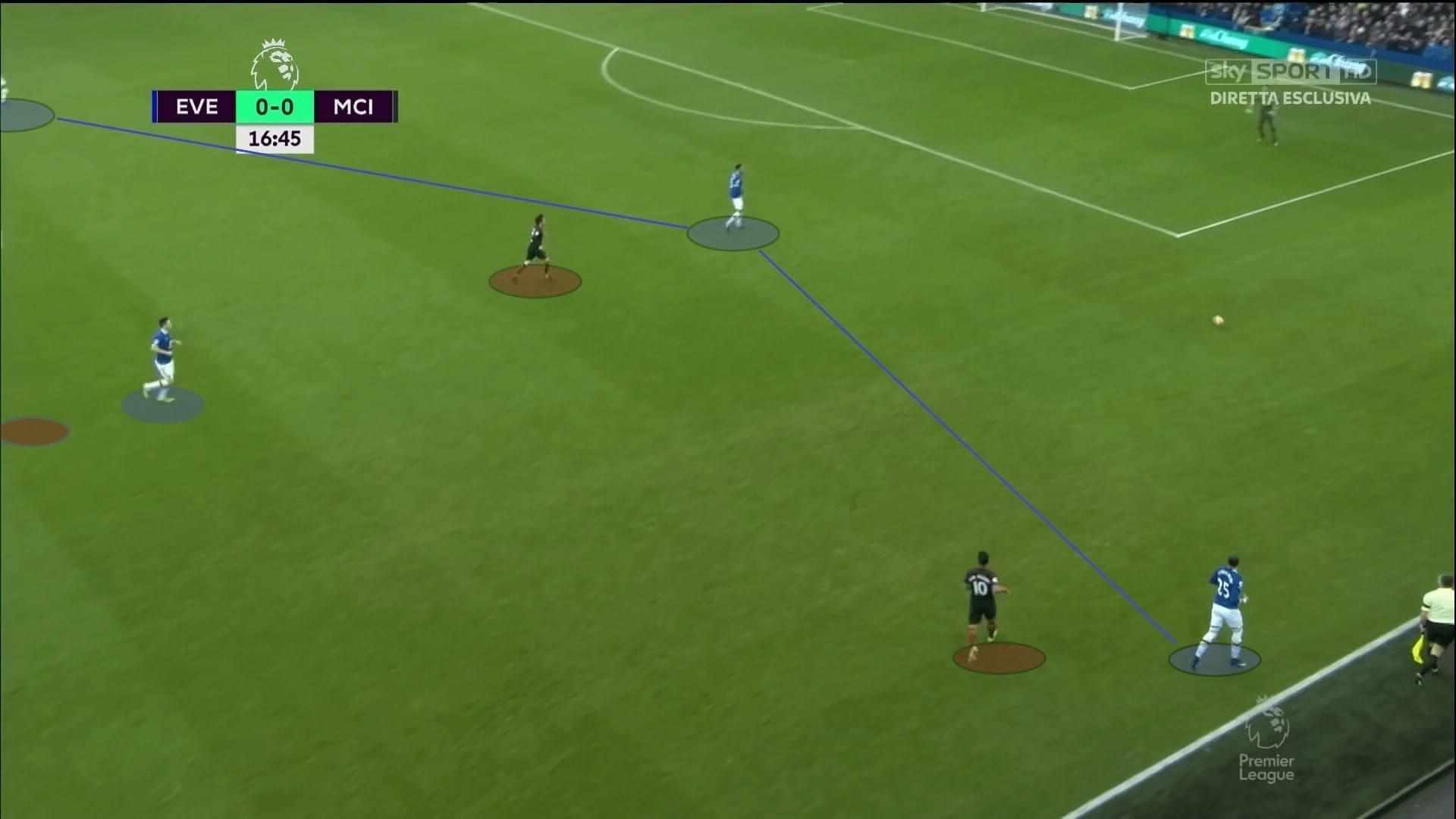
As explained, the horizontal distance of City defenders was large, as illustrated in the following image. You could see Barkley was free from pressure and he was carrying the ball forward. Meanwhile, Mirallas quickly ran between Stones and Clichy, and Touré was unable to track him.
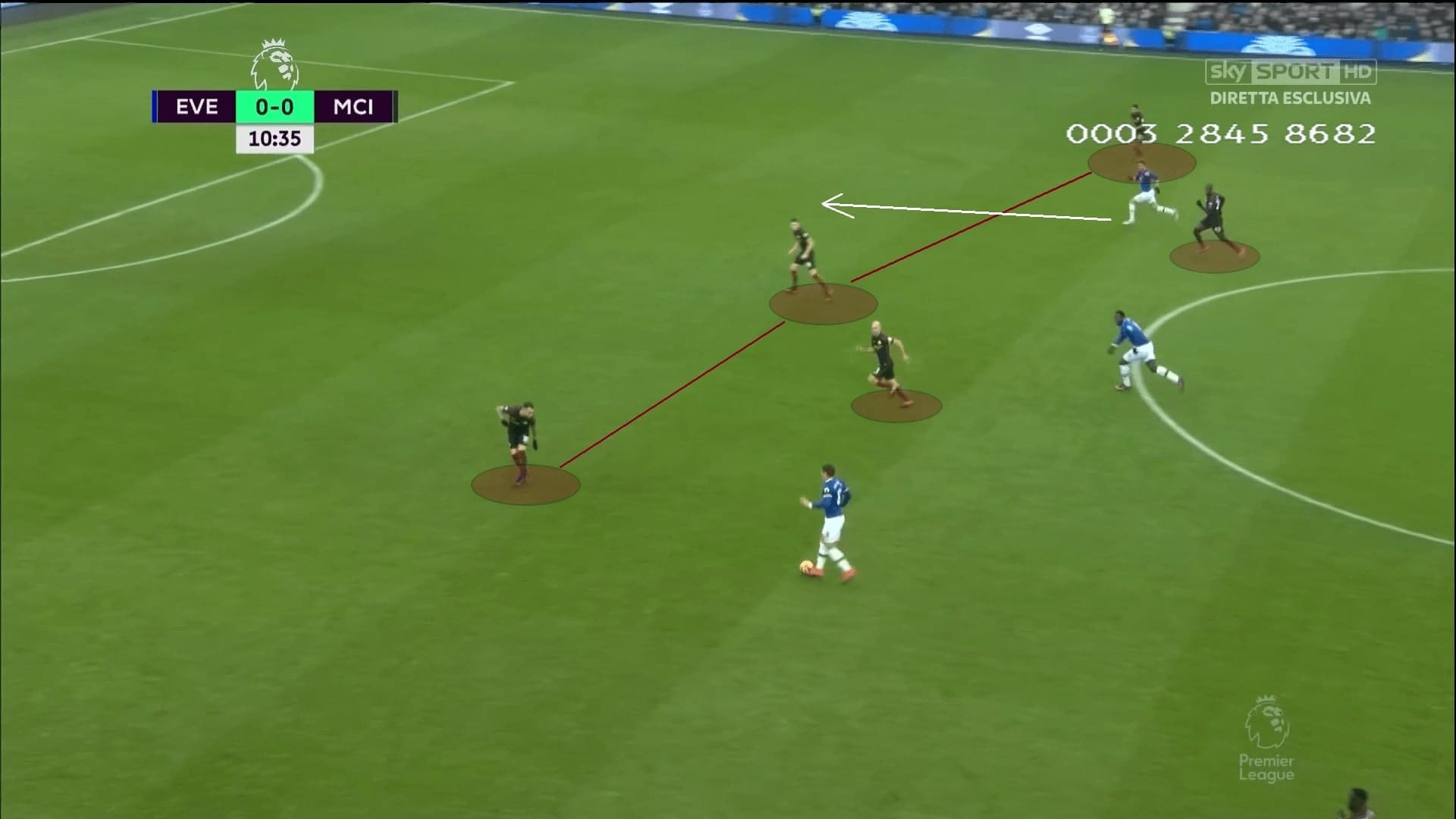
If not penetrating centrally, then, Koeman’s troop attacked the full-backs, mainly on Clichy’s side. In the second half, they even moved Lukaku to the wide areas to start the attack. During the transitions, they hit spaces behind the Frenchman. Or, as indicated in the below image, they committed a wing-back to create an overload on Clichy.
Since City did not have any wingers or wide players, Coleman was totally free to come forward. In this situation, he overlapped and crossed. It was impossible for Clichy to defend both players alone.
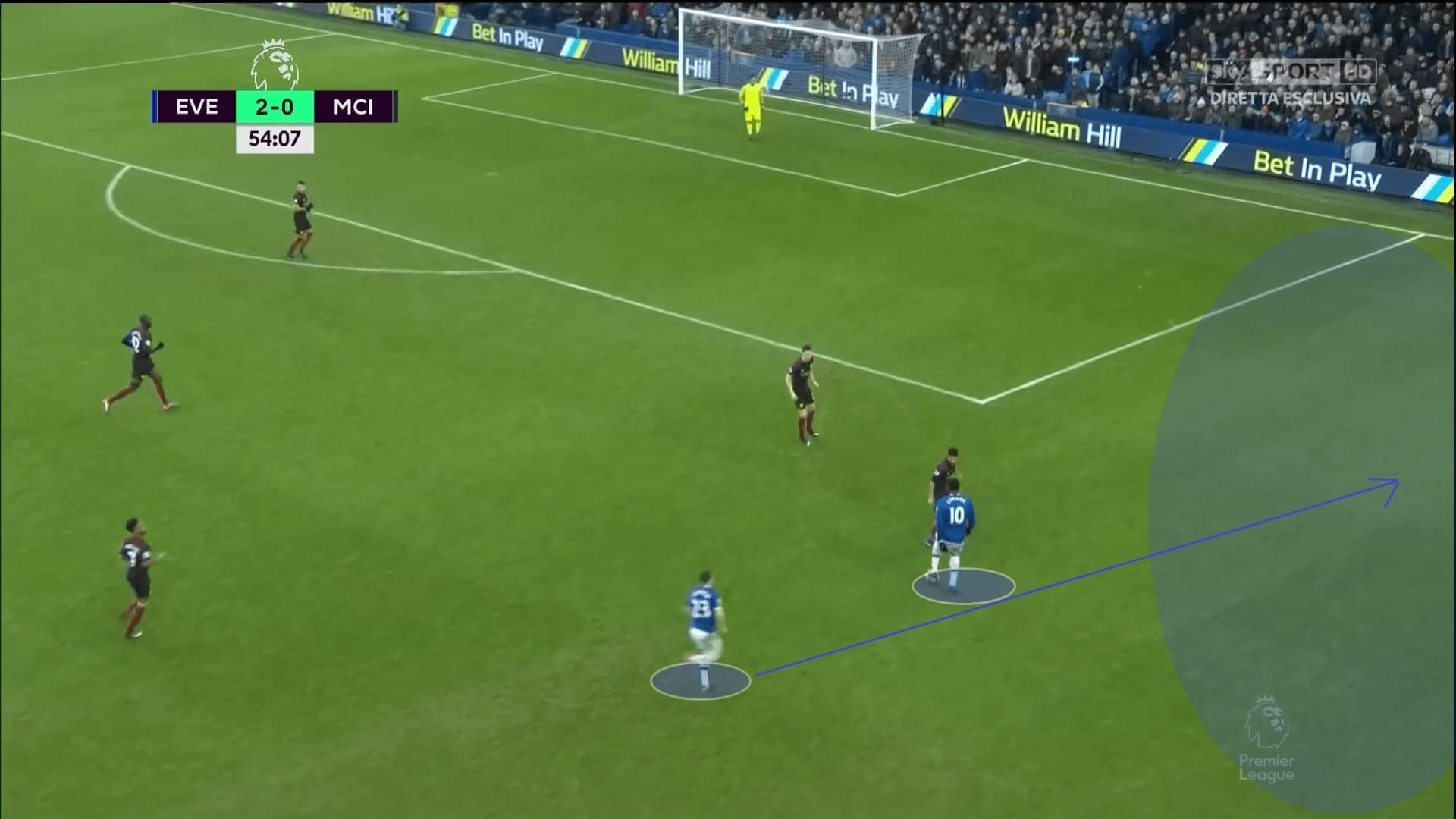
Conclusions
This match saw Everton put four past Claudio Bravo. However, the xG totals of the game were 1.23 – 0.81. The Toffees were very clinical to score four, and they spent a lot of efforts to create those chances. Defensively, they covered spaces quickly and gave City a difficult game, concluding in a well-deserved victory for Koeman’s men.
Of course, City were not playing at the top standard. However, it was a complicated matter as the problem was a sum of different issues. They had an ageing squad at that moment with limited choices of players at the midfield. Tactically, the weaknesses of Guardiola’s system were exposed as they lacked young and pacey players in the backline, and in the midfield. Despite the loss, there were still positives, and the prototype of City’s offensive shape which brought them huge success in the future could be seen here as well.





Comments